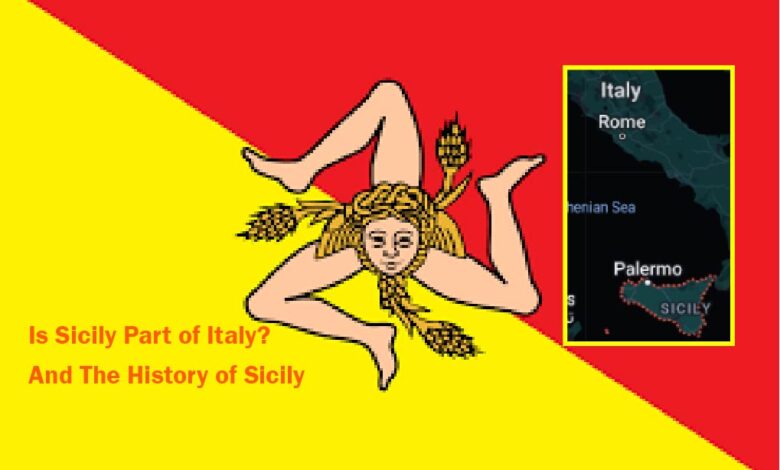Is Sicily Part of Italy? And The History of Sicily

Sicily, the largest island in the Mediterranean Sea, is an intriguing blend of natural beauty, cultural diversity, and historical significance. Situated just off the “toe” of Italy’s boot, Sicily is an autonomous region of Italy. Although it has a distinct identity shaped by its complex history, the island is an integral part of the Italian Republic. But how did ‘is Sicily part of Italy’? And what historical forces have shaped this unique island?
Is Sicily Part of Italy?
Yes, is Sicily part of Italy, only Sicily might as well be its own category. Sicily officially became part of Italy in 1861 when the Kingdom of Italy was unified under King Victor Emmanuel II. Prior to this, management of Sicily had alternated among Greeks, Romans, Arabs, Normans and Spaniards.
Today, Sicily has a special autonomous status within Italy it has its own parliament and president so it can exert some influence on what happens locally, but is still subject to Italian law and nationality governance. Sicily is separated from the Italian mainland by the Strait of Messina, a narrow body of water approximately 3 km (almost 2 mi) wide at its narrowest point.
This separation from the mainland has reinforced Sicily as a distinct and independent entity. Politically and administratively, Sicily has of course been part of Italy for more than 150 years. Following WWII in 1946 Italy was declared a republic with Sicily gaining special autonomous status, highlighting again its regional singularity within the Italian state.
The History of Sicily
Sicily’s history is long and complex, marked by successive waves of conquest, each leaving a distinct imprint on the island’s culture, language, and architecture. From the Greeks to the Romans, and from the Arabs to the Normans, Sicily’s past is a story of domination and resilience.
Early History and Greek Influence
Thousands of years have left their mark on the island’s landscape. The island has been home to many ancient indigenous populations, and the Sicani, Elymians, and Sicels are among the present-day descendants of their legacy. The Greeks first set foot on the island in the 8th century BCE, eventually founding colonies along its eastern and southern coasts, introducing elements of their culture, language, architecture, and art.
Syracuse, Agrigento, and Selinunte were transformed into pivotal cities of Greek civilization. The temples they left some of which still stand today have made Sicily one of the richest archaeological sites for Greek history outside of mainland Greece.
Roman Sicily
Following centuries of struggles between Greek city-states and Carthaginian forces, Rome, as a latecomer in the 3rd century BCE, entered the scene during the Punic Wars. The First Punic War (264-241 BCE) transformed Sicily into the first Roman province, making the island a critical grain supplier for the expanding Roman Empire. Although incorporated into the empire, Sicily preserved its Greek cultural identity, with the Greek language remaining dominant for centuries.
Arab and Norman Rule
After the fall of Roman power in the west, Sicily gradually came under Byzantine influence before being invaded by the Arabs in the 9th century. Aside from bringing citrus fruits, the Arab rulers also brought in more highly developed irrigation systems, which significantly altered the face of Sicilian agriculture.
Sicily’s cultural and economic prosperity under Arab rule is reflected in the splendor of its capital city, Palermo, which was one of the wealthiest cities in Europe. Nevertheless, the Normans ousted the Arabs over one hundred years later. Under Norman rule, Sicily saw a golden age of cultural enlightenment, with Muslims, Christians, and Jews living in harmony.
The Normans constructed grand castles and magnificent cathedrals, blending Arab, Byzantine, and Romanesque styles some of which still stand today. It is widely regarded as one of Sicily’s most culturally rich eras.
Spanish and Bourbon Rule
The island then experienced a turning point in the Late Middle Ages, when it was caught in wars and chaos due to rival rulers vying for control, until it ultimately came under the Spanish Crown through the Crown of Aragon. Sicily remained part of the Spanish Empire for centuries, becoming a constant battleground between European superpowers. In the 18th century, control shifted to the Hapsburgs before the island was ceded to the Bourbon dynasty. Under Bourbon rule, Sicily and Naples were merged to form the “Kingdom of the Two Sicilies.”
Unification with Italy
The modern history of Sicily started at the moment when a movement for Italian unification in the 19th century. In 1860, it was liberated by Giuseppe Garibaldi who played a major role in the unification of Italy. His conquest of Sicily rendered the island part of the Kingdom of Italy the following year.
Sicilian Culture and Identity
Many different cultures have influenced Sicily’s culture over the centuries. The island today is a cultural mosaic that can trace its Modern heritage back to the ancient Greek and Roman times as well as the Arabs, Normans, Spaniards, and many other nations that ruled it. Sicilian architecture is perhaps the apotheosis of this process, melding as it does Greek temples and Roman amphitheaters with Norman-Arab cathedrals to provide a tangible record of the island’s multiple heritage.
Sicilian cooking is a delicious embodiment of the island’s many different owners. Although dishes like pasta alla Norma, cannoli, or arancini have conquered palates abroad, they are made from layers of gastronomic influence from Greek, Arab, and Spanish. Arab agriculture in Sicily, such as lemon and orange trees, still feature strongly in the island’s cooking.
While Sicilian has a lot in common with Italian, there are also elements that point to its long and complex history on the island. Spanish, Norman, and Arabic influences on the local speech make the Sicilian dialect still so varied from Italian that it’s surprising how they communicate. This dialect, widely spoken at home and in neighborhoods, has always been a source of pride among Sicilians.
Sicily’s Economy and Modern Challenges
Sicily’s traditional agriculture, centered on citrus fruits, olives, and vineyards, continues to thrive. In fact, Sicily ranks as the third-largest wine-producing region in Italy due to its rich volcanic soil and favorable climate. Almonds, wheat, and olive oil introduced during the Arab period are also significant crops.
However, despite its natural beauty and agricultural prosperity, Sicily faces significant challenges. It remains one of Italy’s most impoverished regions, grappling with high unemployment and stagnation. Organized crime, particularly the Sicilian Mafia, has historically hindered economic growth, though its influence has waned in recent years.
Efforts are underway to diversify Sicily’s economy by boosting tourism, one of its greatest opportunities. Sicily, with its long history and rich cultural and natural heritage, has become a major destination for tourists. Key attractions such as the Valley of the Temples in Agrigento, the Roman mosaics of Villa Romana del Casale, and the vibrant city of Palermo continue to draw international visitors.
Sicily’s Role in Italian Nationalism
Cavour drove Italy’s unification in the 19th century, with Sicily playing a key role. The island’s annexation to Italy was a significant step toward forming the modern Italian state, beginning in earnest with Giuseppe Garibaldi’s expedition to Sicily in 1860.
Despite this, Sicilians have maintained a strong regional pride, with many considering themselves Sicilians first and Italians second. Sicily’s special autonomous status, granted in 1946, underscores its importance within Italy. While sharing language and government, its political autonomy allows a distinct legal framework, especially in education, tourism, and cultural preservation.
Sicily Today
Sicily, even though an official region of Italy for more than 150 years, maintains its unique cultural identity. The island’s culinary tradition stands out, shaped by a rich history and influenced by Italy’s diverse heritage. In many respects, Sicily remains distinct from mainstream Italian culture. Economically, stagnation and underdevelopment have long characterized the island, though improvements are emerging. Despite challenges, Sicily attracts millions of visitors yearly with its history, stunning landscapes, and rich culture.





